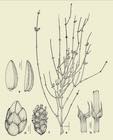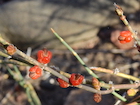Ephedra triandra
Tul. 1858
Common names
Frutilla del Campo (Bell and Bachman 2011).
Taxonomic notes
Molecular analysis has found E. rupestris, E. triandra and E. tweediana to comprise a basal clade sister to the other South American species of Ephedra (Rydin and Korall 2009).
Description
Dioecious, rhizomatous shrub to 2 m tall, or climbing. Twigs flexuous to pendulous, striated. Leaves 2.5-4 mm long, deciduous, sharp apex, papyraceous. Pollen cones oblong-ovoid to oblong, generally simple, sessile, opposite, or grouped; bracts 7-11, decussate, fused to approx. half their length. Seed cones sessile, bracts of upper pair fused to 1/3-1/2 of their length. Mature seed cone fleshy, ruby red. Seeds 2 (Martínez Carretero 2018).
Martínez Carretero (2018) also gives a key to the six Argentine species of Ephedra.
Distribution and Ecology
Argentina and Bolivia, at elevations of 300 to 3000 m in semi-arid areas, often in disturbed areas, in sandy soil on rocky hillsides, in gulches and on clay bluffs. The plant is common, abundant, widespread, and there are no recorded threats; thus it is not of conservation concern (Bell and Bachman 2011).
Remarkable Specimens
No data as of 2023.03.03.
Ethnobotany
Observations
Remarks
The epithet triandra (Latin) means "having 3 stamens".
Citations
Bell, A. and S. Bachman. 2011. Ephedra ochreata. The IUCN Red List of Threatened Species 2011. https://www.iucnredlist.org/species/201670/9160896, accessed 2021.12.27.
Martínez Carretero, Eduardo. 2018. Ephedraceae Dumort. in Flora de Mendoza, Multequina 27: Fascículo 10, FM 1-9. Available: https://www.redalyc.org/jatsRepo/428/42857911008/42857911008.pdf, accessed 2021.12.26.
Rydin, C., and P. Korall. 2009. Evolutionary relationships in Ephedra (Gnetales), with implications for seed plant phylogeny. International Journal of Plant Sciences 170(8):1031–1043. doi:10.1086/605116.
Tulasne, E. 1858. Gnetaceae Americae Australis. Ann. Sci. Nat., Bot., sér. 4, v.10, p.125. Available: Biodiversity Heritage Library, accessed 2021.12.27.
See also
Species profile at Plants of the World Online, accessed 2021.12.27.




